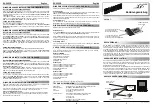
Overview
Do any of the pins on the target device provide power?
Some target devices have a pin dedicated to power in or power out. Power pins are sometimes used to power
other RS232 devices attached to the target device. RS232 specifications do not allow power on any pins but
that does not stop a designer from applying power to an unused pin. You should know about any power pins
before connecting the NET232 to a target device.
What is the Baud Rate, Data Bits, Parity and number of Stop Bits required by the target device?
You must know the communication parameters to setup the NET232 properly. In a typical device, you
might see the baud rate set to 9600, the data bits set to 8, the parity set to none, and the stop bits set to 1.
This is the default setting for the NET232 serial port. If your target device has something different, you will
have to change the serial port configuration.
Do you want your software application to run like it does when your PC is connected to the target device
with an RS232 cable?
Since the NET232 will be using an Ethernet connection to connect your PC to a target device, you will need
some way for your software application to think it is still using a COM port instead of an Ethernet
application. This is done with a software package called COM Port Redirector. It redirects a virtual com port
to an Ethernet port.
Your application will change from a physical port, like COM2, to a virtual comm port like COM20. Your
application does not know the difference. Instead of sending your program data to a physical port, your
program data now goes to a virtual port. The virtual port is an Ethernet port assigned by Comm Port
Redirector software. You tell Comm Redirector the IP address and the port number of the NET232 and it
takes care of routing the data from your application to the Ethernet port.
2.3 Protocol Support
The NET232/USB uses the Internet Protocol (IP) for network communications and the Transmission
Control Protocol (TCP) to assure that no data is lost or duplicated, and that everything sent to the connection
arrives correctly at the target.
Other supported protocols include:
•
ARP, UDP, TCP, ICMP, Telnet, TFTP, AutoIP, DHCP, HTTP, and SNMP for network
communications and management.
•
TCP, UDP, and Telnet for connections to the serial port.
•
TFTP for firmware and web page updates.
•
IP for addressing, routing, and data block handling over the network.
•
User Datagram Protocol (UDP) for typical datagram applications in which devices interact with
other devices without maintaining a point-to-point connection.
•
SMTP for e-mail transmission.
2-4
NET232/NETUSB User Guide
Содержание NET232
Страница 1: ...NET232 NETUSB Serial to Ethernet Adapter Revision C July 25 2008 Document Part Number GC 800 232 ...
Страница 2: ......
Страница 56: ......
Страница 58: ......
Страница 62: ......
Страница 65: ...NET232 NETUSB User Guide 6 1 ...















































